John tyndall Study guides, Revision notes & Summaries
Looking for the best study guides, study notes and summaries about John tyndall? On this page you'll find 76 study documents about John tyndall.
Page 3 out of 76 results
Sort by
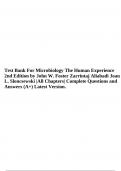
-
Test Bank For Microbiology The Human Experience 2nd Edition by John W. Foster Zarrintaj Aliabadi Joan L. Sloncsewski |All Chapters| Complete Questions and Answers (A+) Latest Version.
- Exam (elaborations) • 422 pages • 2023
-
- £21.84
- + learn more
Test Bank For Microbiology The Human Experience 2nd Edition by John W. Foster Zarrintaj Aliabadi Joan L. Sloncsewski |All Chapters| Complete Questions and Answers (A+) Latest Version. Chapter 01: Microbes Shape Our History MULTIPLE CHOICE 1. Which of the following is NOT considered a benefit of microorganisms? a. nitrogen fixation c. synthesis of vitamins b. production of fermented foods d. causative agents of disease ANS: D DIF: Easy REF: 1.1 OBJ: 1.1a Describe how we define a microbe, a...
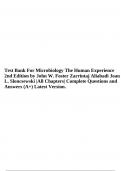
-
Test Bank For Microbiology The Human Experience 2nd Edition by John W. Foster Zarrintaj Aliabadi Joan L. Sloncsewski |All Chapters| Complete Questions and Answers (A+) Latest Version.
- Exam (elaborations) • 422 pages • 2023
-
- £21.04
- + learn more
Test Bank For Microbiology The Human Experience 2nd Edition by John W. Foster Zarrintaj Aliabadi Joan L. Sloncsewski |All Chapters| Complete Questions and Answers (A+) Latest Version. Chapter 01: Microbes Shape Our History MULTIPLE CHOICE 1. Which of the following is NOT considered a benefit of microorganisms? a. nitrogen fixation c. synthesis of vitamins b. production of fermented foods d. causative agents of disease ANS: D DIF: Easy REF: 1.1 OBJ: 1.1a Describe how we define a microbe, a...

-
TCDHA Microbiology Quiz 1 and Midterm Questions and Answers 100% Accurate.
- Exam (elaborations) • 4 pages • 2024
- Available in package deal
-
- £9.70
- + learn more
Give two examples of a eukaryotic microorganism. - ANSWER-yeast, grass, trees, plants, animals Give an example of a prokaryote. - ANSWER-bacteria Describe characteristics of both eukaryotic and prokaryotic microorganisms. - ANSWER-Eukaryotes are complex cells with internal membranes (has a nucleus) Prokaryotes are primitive cells with internal membrane (no nucleus) Girolamo Fracastoro - ANSWER-catching diseases (1500s) Antoni V.L - ANSWER-microbes (1600s) Edward Jenner - ANSWER-D...
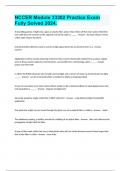
-
NCCER Module 33302 Practice Exam Fully Solved 2024.
- Exam (elaborations) • 4 pages • 2024
- Available in package deal
-
- £6.87
- + learn more
Transmitting pulses of light into a glass or plastic fiber, where they reflect off the inner walls of the fiber core until they are received at the opposite end of the cable is _____ - Answer the basic theory of how a fiber optic system functions A photosensitive detector used to convert a light signal back into an electrical form is a - Answer receiver Applications where remote powering of devices that must be electrically isolated from a power supply, such as those used in explosive ...
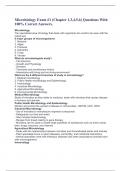
-
Microbiology Exam #1 (Chapter 1,3,4,5,6) Questions With 100% Correct Answers.
- Exam (elaborations) • 23 pages • 2024
-
- £12.94
- + learn more
Microbiology Exam #1 (Chapter 1,3,4,5,6) Questions With 100% Correct Answers. Microbiology The specialized area of biology that deals with organisms too small to be seen with the naked eye 6 major groups of microorganisms 1. Bacteria 2. Algae 3. Protozoa 4. Helminths 5. Fungi 6. Viruses What do microbiologists study? - Cell structure - Growth and Physiology - Genetics - Taxonomy and evolutionary history - Interactions with living and non living environment What are the 6 differ...
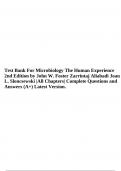
-
Test Bank For Microbiology The Human Experience 2nd Edition by John W. Foster Zarrintaj Aliabadi Joan L. Sloncsewski |All Chapters| Complete Questions and Answers (A+) Latest Version.
- Exam (elaborations) • 422 pages • 2023
-
- £21.04
- + learn more
Test Bank For Microbiology The Human Experience 2nd Edition by John W. Foster Zarrintaj Aliabadi Joan L. Sloncsewski |All Chapters| Complete Questions and Answers (A+) Latest Version. Chapter 01: Microbes Shape Our History MULTIPLE CHOICE 1. Which of the following is NOT considered a benefit of microorganisms? a. nitrogen fixation c. synthesis of vitamins b. production of fermented foods d. causative agents of disease ANS: D DIF: Easy REF: 1.1 OBJ: 1.1a Describe how we define a microbe, a...
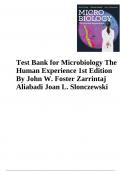
-
Test Bank for Microbiology The Human Experience 1st Edition By John W. Foster Zarrintaj Aliabadi Joan L. Slonczewski||ISBN NO-10 0393906094||ISBN NO-13 978-0393906097||All Chapters||Complete Guide A+
- Exam (elaborations) • 422 pages • 2023
-
- £20.23
- + learn more
Test Bank for Microbiology The Human Experience 1st Edition By John W. Foster Zarrintaj Aliabadi Joan L. Slonczewski COMPLETE. Microbes Shape Our History MULTIPLE CHOICE 1. Which of the following is NOT considered a benefit of microorganisms? a. nitrogen fixation c. synthesis of vitamins b. production of fermented foods d. causative agents of disease ANS: D DIF: Easy REF: 1.1 OBJ: 1.1a Describe how we define a microbe, and explain why the definition is a challenge. MSC: Remembering 2. A microbe ...

-
Microbiology EXAM 1 (Chapters 1,3,4 and 6) Questions With Complete Answers.
- Exam (elaborations) • 17 pages • 2024
-
- £10.51
- + learn more
Microbiology EXAM 1 (Chapters 1,3,4 and 6) Questions With Complete Answers. microobiology The study of organisms too small to be seen with the naked eye is _______ viruses, bacteria, algae, protozoa, fungi and helminths What are the six major groups of microorganisms? 3.5 billion years ago Single celled organisms arose ______ million years ago and have been shaping our earth ever since Eukaryotes = have a true nucleus (include protozoa, fungi, plants and animals) Prokaryotes= lack a tr...
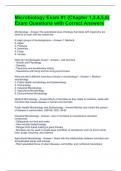
-
Microbiology Exam #1 (Chapter 1,3,4,5,6) Exam Questions with Correct Answers
- Exam (elaborations) • 24 pages • 2024
- Available in package deal
-
- £13.35
- + learn more
Microbiology Exam #1 (Chapter 1,3,4,5,6) Exam Questions with Correct Answers Describe the most recent scientific discoveries that have made an impact in the field of microbiology. - Answer-1970s: Discovery of restriction enzymes 1980s: Inventions of the PCR technique 2000s: Importance of small RNAs 2010s: Role of the human microbiome What is John Tyndall responsible for in Microbiology? - Answer-Found that microbes in the dust and air have high heat resistance What is Ferdinand Cohn ...
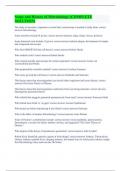
-
Scope and History of Microbiology (COMPLETE SOLUTION)
- Exam (elaborations) • 3 pages • 2023
- Available in package deal
-
- £6.47
- + learn more
The study of microbes, organisms so small that a microscope is needed to study them. correct answers Microbiology Some microbes include (4 given): correct answers bacteria, algae, fungi, viruses, protozoa Some historical roots include (2 given): correct answers bubonic plague, development of simple and compound microscope Who first OBSERVED the cell theory? correct answers Robert Hooke Who studied corks? correct answers Robert Hooke Who created specific microscopes for certain org...

£5.50 for your revision notes multiplied by 100 fellow students... Do the math: that's a lot of money! Don't be a thief of your own wallet and start uploading yours now. Discover all about earning on Stuvia


